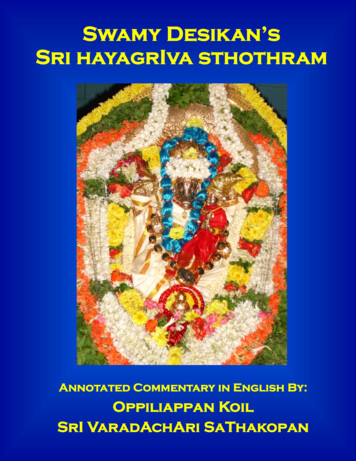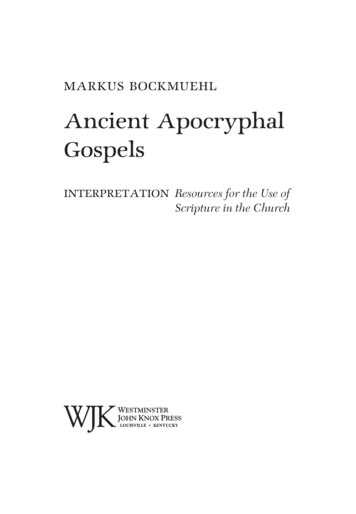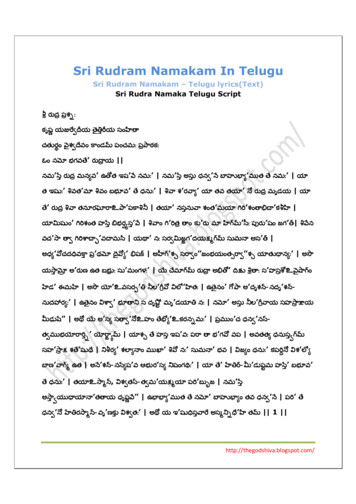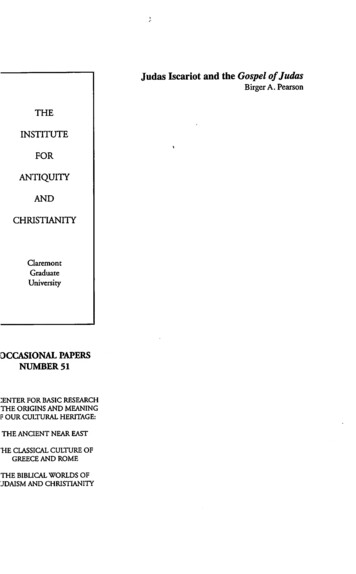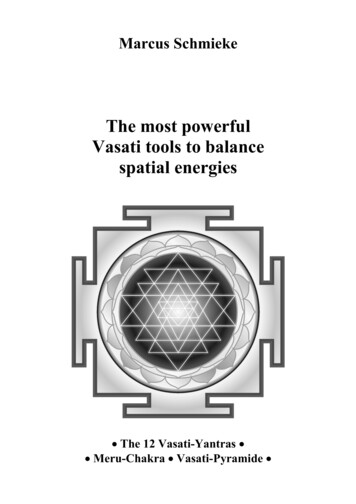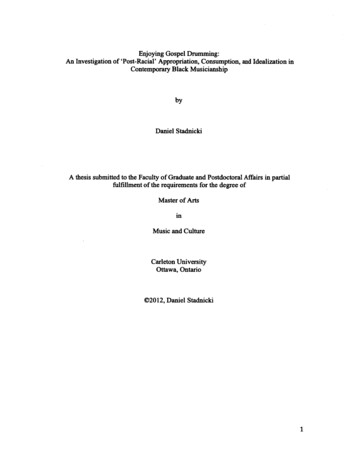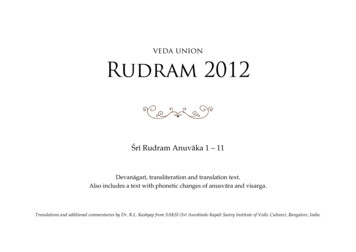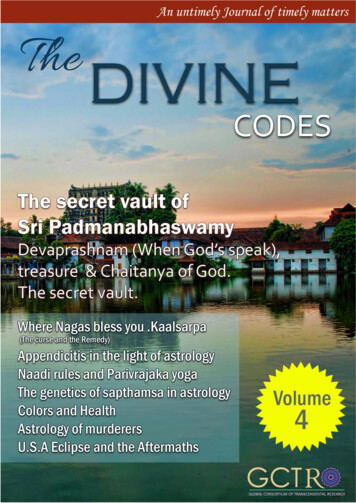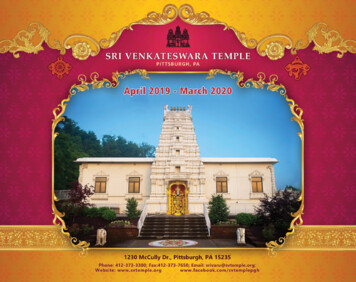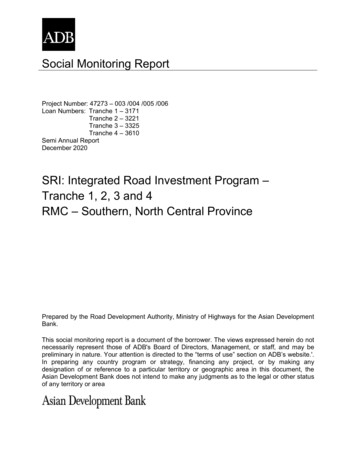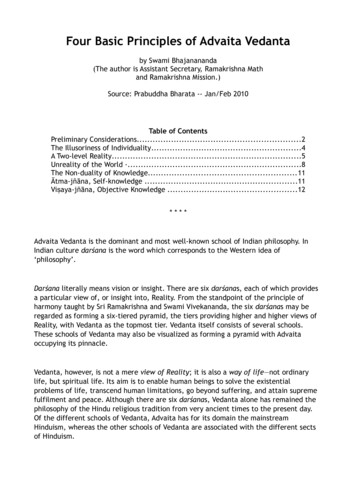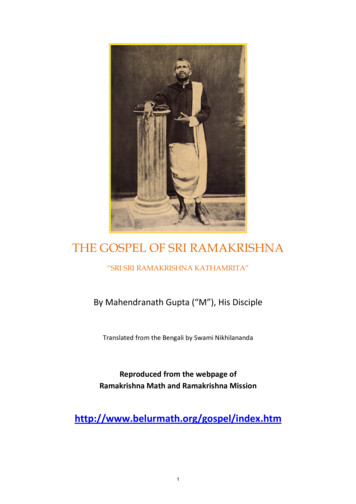
Transcription
THE GOSPEL OF SRI RAMAKRISHNA“SRI SRI RAMAKRISHNA KATHAMRITA”By Mahendranath Gupta (“M”), His DiscipleTranslated from the Bengali by Swami NikhilanandaReproduced from the webpage ofRamakrishna Math and Ramakrishna Missionhttp://www.belurmath.org/gospel/index.htm1
FOREWORDby Aldous HuxleyIN THE HISTORY of the arts, genius is a thing of very rare occurrence. Rarer still,however, are the competent reporters and recorders of that genius. The world has hadmany hundreds of admirable poets and philosophers; but of these hundreds only a veryfew have had the fortune to attract a Boswell or an Eckermann.When we leave the field of art for that of spiritual religion, the scarcity of competentreporters becomes even more strongly marked. Of the day-to-day life of the greattheocentric saints and contemplatives we know, in the great majority of cases, nothingwhatever. Many, it is true, have recorded their doctrines in writing, and a few, such asSt. Augustine, Suso and St. Teresa, have left us autobiographies of the greatest value.But, all doctrinal writing is in some measure formal and impersonal, while theautobiographer tends to omit what he regards as trifling matters and suffers from thefurther disadvantage of being unable to say how he strikes other people and in what wayhe affects their lives. Moreover, most saints have left neither writings nor self-portraits,and for knowledge of their lives, their characters and their teachings, we are forced torely upon the records made by their disciples who, in most cases, have provedthemselves singularly incompetent as reporters and biographers. Hence the specialinterest attaching to this enormously detailed account of the daily life and conversationsof Sri Ramakrishna."M", as the author modestly styles himself, was peculiarly qualified for his task. To areverent love for his master, to a deep and experiential knowledge of that master'steaching, he added a prodigious memory for the small happenings of each day and ahappy gift for recording them in an interesting and realistic way. Making good use of hisnatural gifts and of the circumstances in which he found himself, "M" produced a bookunique, so far as my knowledge goes, in the literature of hagiography. No other sainthas had so able and indefatigable a Boswell. Never have the small events of acontemplative's daily life been described with such a wealth of intimate detail. Neverhave the casual and unstudied utterances of a great religious teacher been set downwith so minute a fidelity. To Western readers, it is true, this fidelity and this wealth ofdetail are sometimes a trifle disconcerting; for the social, religious and intellectualframes of reference within which Sri Ramakrishna did his thinking and expressed hisfeelings were entirely Indian. But after the first few surprises and bewilderments, webegin to find something peculiarly stimulating and instructive about the very strangenessand, to our eyes, the eccentricity of the man revealed to us in "M's" narrative. What ascholastic philosopher would call the "accidents" of Ramakrishna's life were intenselyHindu and therefore, so far as we in the West are concerned, unfamiliar and hard tounderstand; its "essence", however, was intensely mystical and therefore universal. Toread through these conversations in which mystical doctrine alternates with anunfamiliar kind of humour, and where discussions of the oddest aspects of Hindumythology give place to the most profound and subtle utterances about the nature ofUltimate Reality, is in itself a liberal, education in humility, tolerance and suspense of2
judgment. We must be grateful to the translator for his excellent version of a book socurious and delightful as a biographical document, so precious, at the same time, forwhat it teaches us of the life of the spirit.--------------------3
PREFACEby Swāmi NikhilānandaThe Gospel of Sri Ramakrishna is the English translation of theKathāmrita,Sri Sri Rāmakrishnathe conversations of Sri Ramakrishna with his disciples, devotees, andvisitors, recorded by Mahendranāth Gupta, who wrote the book under the pseudonym of"M." The conversations in Bengali fill five volumes, the first of which was published in1897 and the last shortly after M.'s death in 1932. Sri Ramakrishna Math, Madras, haspublished in two volumes an English translation of selected chapters from themonumental Bengali work. I have consulted these while preparing my translation.M., one of the intimate disciples of Sri Ramakrishna, was present during all theconversations recorded in the main body of the book and noted them down in his diary.They therefore have the value of almost stenographic records. In Appendix A are givenseveral conversations which took place in the absence of M., but of which he received afirst-hand record from persons concerned. The conversations will bring before thereader's mind an intimate picture of the Master's eventful life from March 1882 to April24, 1886, only a few months before his passing away. During this period he came incontact chiefly with English-educated Bengālis; from among them he selected hisdisciples and the bearers of his message, and with them he shared his rich spiritualexperiences.I have made a literal translation, omitting only a few pages of no particular interest toEnglish-speaking readers. Often literary grace has been sacrificed for the sake of literaltranslation. No translation can do full justice to the original. This difficulty is all themore felt in the present work, whose contents are of a deep mystical nature anddescribe the inner experiences of a great seer. Human language is an altogetherinadequate vehicle to express supersensuous perception. Sri Ramakrishna was almostilliterate. He never clothed his thoughts in formal language. His words sought to conveyhis direct realization of Truth. His conversation was in a village patois. Therein lies itscharm. In order to explain to his listeners an abstruse philosophy, he, like Christ beforehim, used with telling effect homely parables and illustrations, culled from hisobservation of the daily life around him.The reader will find mentioned in this work many visions and experiences that falloutside the ken of physical science and even psychology. With the development ofmodern knowledge the border line between the natural and the supernatural is evershifting its position. Genuine mystical experiences are not as suspect now as they werehalf a century ago. The words of Sri Ramakrishna have already exerted a tremendousinfluence in the land of his birth. Savants of Europe have found in his words the ring ofuniversal truth.But these words were not the product of intellectual cogitation; they were rooted indirect experience. Hence, to students of religion, psychology, and physical science,these experiences of the Master are of immense value for the understanding of religious4
phenomena in general. No doubt Sri Ramakrishna was a Hindu of the Hindus; yet hisexperiences transcended the limits of the dogmas and creeds of Hinduism. Mystics ofreligions other than Hinduism will find in Sri Ramakrishna's experiences a corroborationof the experiences of their own prophets and seers. And this is very important today forthe resuscitation of religious values. The sceptical reader may pass by the supernaturalexperiences; he will yet find in the book enough material to provoke his serious thoughtand solve many of his spiritual problems.There are repetitions of teachings and parables in the book. I have kept thempurposely. They have their charm and usefulness, repeated as they were in differentsettings. Repetition is unavoidable in a work of this kind. In the first place, differentseekers come to a religious teacher with questions of more or less identical nature;hence the answers will be of more or less identical pattern. Besides, religious teachersof all times and climes have tried, by means of repetition, to hammer truths into thestony soil of the recalcitrant human mind. Finally, repetition does not seem tedious ifthe ideas repeated are dear to a man's heart.I have thought it necessary to write a rather lengthy Introduction to the book. In it Ihave given the biography of the Master, descriptions of people who came in contact withhim, short explanations of several systems of Indian religious thought intimatelyconnected with Sri Ramakrishna's life, and other relevant matters which, I hope, willenable the reader better to understand and appreciate the unusual contents of thisbook. It is particularly important that the Western reader, unacquainted with Hindureligious thought, should first read carefully the introductory chapter, in order that hemay fully enjoy these conversations. Many Indian terms and names have been retainedin the book for want of suitable English equivalents. Their meaning is given either in theGlossary or in the foot-notes. The Glossary also gives explanations of a number ofexpressions unfamiliar to Western readers. The diacritical marks are explained underNotes on Pronunciation.In the Introduction I have drawn much material from the Life of Sri Ramakrishna,published by the Advaita Ashrama, Māyāvati, India. I have also consulted the excellentarticle on Sri Ramakrishna by Swami Nirvedānanda, in the second volume of the CulturalHeritage of India.The book contains many songs sung either by the Master or by the devotees. Theseform an important feature of the spiritual tradition of Bengal and were for the most partwritten by men of mystical experience. For giving the songs their present form I amgrateful to Mr. John Moffitt, Jr.In the preparation of this manuscript I have received ungrudging help from severalfriends. Miss Margaret Woodrow Wilson and Mr.Joseph Campbell have worked hard inediting my translation. Mrs.Elizabeth Davidson has typed, more than once, the entiremanuscript and rendered other valuable help. Mr.Aldous Huxley has laid me under adebt of gratitude by writing the Foreword. I sincerely thank them all.5
In the spiritual firmament Sri Ramakrishna is a waxing crescent. Within one hundredyears of his birth and fifty years of his death his message has spread across land andsea. Romain Rolland has described him as the fulfilment of the spiritual aspirations ofthe three hundred millions of Hindus for the last two thousand years. Mahatma Gandhihas written: "His life enables us to see God face to face. . . . Ramakrishna was a livingembodiment of godliness." He is being recognized as a compeer of Krishna, Buddha, andChrist.The life and teachings of Sri Ramakrishna have redirected the thoughts of thedenationalized Hindus to the spiritual ideals of their forefathers. During the latter part ofthe nineteenth century his was the time-honoured role of the Saviour of the EternalReligion of the Hindus. His teachings played an important part in liberalizing the mindsof orthodox pundits and hermits. Even now he is the silent force that is moulding thespiritual destiny of India. His great disciple, Swami Vivekananda, was the first Hindumissionary to preach the message of Indian culture to the enlightened minds of Europeand America. The full consequence of Swami Vivekānandā work is still in the womb ofthe future.May this translation of the first book of its kind in the religious history of the world, beingthe record of the direct words of a prophet, help stricken humanity to come nearer to theEternal Verity of life and remove dissension and quarrel from among the different faiths!May it enable seekers of Truth to grasp the subtle laws of the supersensuous realm, andunfold before man's restricted vision the spiritual foundation of the universe, the unity ofexistence, and the divinity of the soul!- Swāmi NikhilānandaNew YorkSri Ramakrishna's BirthdayFebruary 1942--------------------------6
The Recorder of the GospelMAHENDRANĀTH GUPTAIn the life of the great Saviours and Prophets of the world it is often found that they areaccompanied by souls of high spiritual potency who play a conspicuous part in thefurtherance of their Master's mission. They become so integral a part of the life and workof these great ones that posterity can think of them only in mutual association. Such isthe case with Sri Ramakrishna and M., whose diary has come to be known to the worldas the Gospel of Sri Ramakrishna in English and as Sri Rāmakrishna Kathāmrita inthe original Bengali version.Sri Mahendra Nath Gupta, familiary known to the readers of the Gospel by his pen nameM., and to the devotees as Master Mahashay, was born on the 14th of July, 1854 as theson of Madhusudan Gupta, an officer of the Calcutta High Court, and his wife,Swarnamayi Devi. He had a brilliant scholastic career at Hare School and the PresidencyCollege at Calcutta. The range of his studies included the best that both occidental andoriental learning had to offer. English literature, history, economics, western philosophyand law on the one hand, and Sanskrit literature and grammar, Darsanas, Puranas,Smritis, Jainism, Buddhism, astrology and Ayurveda on the other were the subjects inwhich he attained considerable proficiency.He was an educationist all his life both in a spiritual and in a secular sense. After hepassed out of College, he took up work as headmaster in a number of schools insuccession Narail High School, City School, Ripon College School, Metropolitan School,Aryan School, Oriental School, Oriental Seminary and Model School. The causes of hismigration from school to school were that he could not get on with some of themanagements on grounds of principles and that often his spiritual mood drew him awayto places of pilgrimage for long periods. He worked with some of the most noted publicmen of the time like Iswar Chandra Vidyāsāgar and Surendranath Banerjee. The latterappointed him as a professor in the City and Ripon Colleges where he taught subjectslike English, philosophy, history and economics. In his later days he took over theMorton School, and he spent his time in the staircase room of the third floor of it,administering the school and preaching the message of the Master. He was muchrespected in educational circles where he was usually referred to as Rector Mahashay. Ateacher who had worked under him writes thus in warm appreciation of his teachingmethods: "Only when I worked with him in school could I appreciate what a greateducationist he was. He would come down to the level of his students when teaching,though he himself was so learned, so talented. Ordinarily teachers confine theirinstruction to what is given in books without much thought as to whether the studentcan accept it or not. But M., would first of all gauge how much the student could take inand by what means. He would employ aids to teaching like maps, pictures and diagrams,so that his students could learn by seeing. Thirty years ago (from 1953) when thequestion of imparting education through the medium of the mother tongue was being7
discussed, M. had already employed Bengali as the medium of instruction in the MortonSchool." (M The Apostle and the Evangelist by Swami Nityatmananda Part I. P. 15.)Imparting secular education was, however, only his profession ; his main concern waswith the spiritual regeneration of man a calling for which Destiny seems to have chosenhim. From his childhood he was deeply pious, and he used to be moved very much bySādhus, temples and Durga Puja celebrations. The piety and eloquence of the greatBrahmo leader of the times, Keshab Chander Sen, elicited a powerful response from theimpressionable mind of Mahendra Nath, as it did in the case of many an idealistic youngman of Calcutta, and prepared him to receive the great Light that was to dawn on himwith the coming of Sri Ramakrishna into his life.This epoch-making event of his life came about in a very strange way. M. belonged to ajoint family with several collateral members. Some ten years after he began his careeras an educationist, bitter quarrels broke out among the members of the family, drivingthe sensitive M. to despair and utter despondency. He lost all interest in life and lefthome one night to go into the wide world with the idea of ending his life. At dead ofnight he took rest in his sister's house at Baranagar, and in the morning, accompaniedby a nephew Siddheswar, he wandered from one garden to another in Calcutta untilSiddheswar brought him to the Temple Garden of Dakshineswar where Sri Ramakrishnawas then living. After spending some time in the beautiful rose gardens there, he wasdirected to the room of the Paramahamsa, where the eventful meeting of the Master andthe disciple took place on a blessed evening (the exact date is not on record) on aSunday in March 1882. As regards what took place on the occasion, the reader isreferred to the opening section of the first chapter of theGospel.The Master, who divined the mood of desperation in M, his resolve to take leave of this'play-field of deception', put new faith and hope into him by his gracious words ofassurance: "God forbid! Why should you take leave of this world? Do you not feelblessed by discovering your Guru? By His grace, what is beyond all imagination ordreams can be easily achieved!" At these words the clouds of despair moved away fromthe horizon of M.'s mind, and the sunshine of a new hope revealed to him fresh vistas ofmeaning in life. Referring to this phase of his life, M. used to say, "Behold! where is theresolve to end life, and where, the discovery of God! That is, sorrow should be lookedupon as a friend of man. God is all good." (Ibid P.33.)After this re-settlement, M's life revolved around the Master, though he continued hisprofessional work as an educationist. During all holidays, including Sundays, he spent histime at Dakshineswar in the Master's company, and at times extended his stay toseveral days.8
It did not take much time for M. to become very intimate with the Master, or for theMaster to recognise in this disciple a divinely commissioned partner in the fulfilment ofhis spiritual mission. When M. was reading out the Chaitanya Bhagavata, the Masterdiscovered that he had been, in a previous birth, a disciple and companion of the greatVaishnava Teacher, Sri Chaitanya Mahaprabhu, and the Master even saw him 'with hisnaked eye' participating in the ecstatic mass-singing of the Lord's name under theleadership of that Divine personality. So the Master told M, "You are my own, of thesame substance as the father and the son," indicating thereby that M. was one of thechosen few and a part and parcel of his Divine mission.There was an urge in M. to abandon the household life and become a Sannyāsin. Whenhe communicated this idea to the Master, he forbade him saying," Mother has told methat you have to do a little of Her work you will have to teach Bhagavata, the word ofGod to humanity. The Mother keeps a Bhagavata Pandit with a bondage in the world!"(Ibid P.36.)An appropriate allusion indeed! Bhagavata, the great scripture that has given the wordof Sri Krishna to mankind, was composed by the Sage Vyāsa under similarcircumstances. When caught up in a mood of depression like that of M, Vyāsa wasadvised by the sage Nārada that he would gain peace of mind only qn composing a workexclusively devoted to the depiction of the Lord's glorious attributes and His teachings onKnowledge and Devotion, and the result was that the world got from Vyāsa theinvaluable gift of the Bhagavata Purana depicting the life and teachings of Sri Krishna.From the mental depression of the modem Vyāsa, the world has obtained theKathāmrita (Bengali Edition) the Gospel of Sri Ramakrishna in English.Sri Ramakrishna was a teacher for both the Orders of mankind, Sannyāsins andhouseholders. His own life offered an ideal example for both, and he left behind discipleswho followed the highest traditions he had set in respect of both these ways of life. M.,along with Nag Mahashay, exemplified how a householder can rise to the highest level ofsagehood. M. was married to Nikunja Devi, a distant relative of Keshab Chander Sen,even when he was reading at College, and he had four children, two sons and twodaughters. The responsibility of the family, no doubt, made him dependent on hisprofessional income, but the great devotee that he was, he never compromised withideals and principles for this reason. Once when he was working as the headmaster in aschool managed by the great Vidyāsāgar, the results of the school at the publicexamination happened to be rather poor, and Vidyāsāgar attributed it to M's preoccupation with the Master and his consequent failure to attend adequately to the schoolwork. M. at once resigned his post without any thought of the morrow. Within a fortnightthe family was in poverty, and M. was one day pacing up and down the verandah of hishouse, musing how he would feed his children the next day. Just then a man came witha letter addressed to 'Mahendra Babu', and on opening it, M. found that it was a letter9
from his friend Sri Surendra Nath Banerjee, asking whether he would like to take up aprofessorship in the Ripon College. In this way three or four times he gave up the jobthat gave him the wherewithal to support the family, either for upholding principles orfor practising spiritual Sadhanas in holy places, without any consideration of the possibledire worldly consequences; but he was always able to get over these difficultiessomehow, and the interests of his family never suffered. In spite of his disregard forworldly goods, he was, towards the latter part of his life, in a fairly flourishing conditionas the proprietor of the Morton School which he developed into a noted educationalinstitution in the city. The Lord has said in the Bhagavad Gitā that in the case of thosewho think of nothing except Him, He Himself would take up all their material andspiritual responsibilities. M. was an example of the truth of the Lord's promise.Though his children received proper attention from him, his real family, both during theMaster's life-time and after, consisted of saints, devotees, Sannyāsins and spiritualaspirants. His life exemplifies the Master's teaching that an ideal householder must belike a good maid-servant of a family, loving and caring properly for the children of thehouse, but knowing always that her real home and children are elsewhere. During theMaster's life-time he spent all his Sundays and other holidays with him and his devotees,and besides listening to the holy talks and devotional music, practised meditation bothon the Personal and the Impersonal aspects of God under the direct guidance of theMaster. In the pages of the Gospel the reader gets a picture of M.'s spiritual relationshipwith the Master how from a hazy belief in the Impersonal God of the Brahmos, he wasstep by step brought to accept both Personality and Impersonality as the two aspects ofthe same Non-dual Being, how he was convinced of the manifestation of that Being asGods, Goddesses and as Incarnations, and how he was established in a life that was bothof a Jnāni and of a Bhakta. This Jnāni-Bhakta outlook and way of living became sodominant a feature of his life that Swami Raghavananda, who was very closelyassociated with him during his last six years, remarks: "Among those who lived with M.in latter days, some felt that he always lived in this constant and conscious union withGod even with open eyes (i.e., even in waking consciousness)." (Swami Raghavananda'sarticle on M. in Prabuddha Bharata vol. XXXVII. P. 442.)Besides undergoing spiritual disciplines at the feet of the Master, M. used to go to holyplaces during the Master's life-time itself and afterwards too as a part of hisSādhanā.He was one of the earliest of the disciples to visit Kamarpukur, the birthplace of theMaster, in the latter's life-time itself; for he wished to practise contemplation on theMaster's early life in its true original setting. His experience there is described as followsby Swami Nityatmananda: "By the grace of the Master, he saw the entire Kamarpukur asa holy place bathed in an effulgent Light. Trees and creepers, beasts and birds and menall were made of effulgence. So he prostrated to all on the road. He saw a torn cat,which appeared to him luminous with the Light of Consciousness. Immediately he fell tothe ground and saluted it" (M The Apostle and the Evangelist by Swami Nityatmanandavol. I. P. 40.) He had similar experience in Dakshineswar also. At the instance of theMaster he also visited Puri, and in the words of Swami Nityatmananda, "with indomitablecourage, M. embraced the image of Jagannath out of season."10
The life of Sādhanā and holy association that he started on at the feet of the Master, hecontinued all through his life. He has for this reason been most appropriately describedas a Grihastha-Sannyāsi (householder-Sannyāsin). Though he was forbidden by theMaster to become a Sannyāsin, his reverence for the Sannyāsa ideal was whole-heartedand was without any reservation. So after Sri Ramakrishna's passing away, while severalof the Master's householder devotees considered the young Sannyāsin disciples of theMaster as inexperienced and inconsequential, M. stood by them with the firm faith thatthe Master's life and message were going to be perpetuated only through them. SwamiVivekananda wrote from America in a letter to the inmates of the Math: "When SriThākur (Master) left the body, every one gave us up as a few unripe urchins. But M. anda few others did not leave us in the lurch. We cannot repay our debt to them." (SwamiRaghavananda's article on M. in Prabuddha Bharata vol. XXX P. 442.)M. spent his weekends and holidays with the monastic brethren who, after the Master'sdemise, had formed themselves into an Order with a Math at Baranagore, andparticipated in the intense life of devotion and meditation that they followed. At othertimes he would retire to Dakshineswar or some garden in the city and spend severaldays in spiritual practice taking simple self-cooked food. In order to feel that he was onewith all mankind he often used to go out of his home at dead of night, and like awandering Sannyāsin, sleep with the waifs on some open verandah or footpath on theroad.After the Master's demise, M. went on pilgrimage several times. He visited Banāras,Vrindāvan, Ayodhyā and other places. At Banāras he visited the famous Trailinga Swāmiand fed him with sweets, and he had long conversations with Swami Bhaskarananda,one of the noted saintly and scholarly Sannyāsins of the time. In 1912 he went with theHoly Mother to Banāras, and spent about a year in the company of Sannyāsins atBanāras, Vrindāvan, Hardwar, Hrishikesh and Swargashram. But he returned to Calcutta,as that city offered him the unique opportunity of associating himself with the placeshallowed by the Master in his life-time. Afterwards he does not seem to have gone toany far-off place, but stayed on in his room in the Morton School carrying on his spiritualministry, speaking on the Master and his teachings to the large number of people whoflocked to him after having read his famous Kathāmrita known to English readers as TheGospel of Sri Ramakrishna.This brings us to the circumstances that led to the writing and publication of thismonumental work, which has made M. one of the immortals in hagiographic literature.While many educated people heard Sri Ramakrishna's talks, it was given to thisillustrious personage alone to leave a graphic and exact account of them for posterity,with details like date, hour, place, names and particulars about participants. Humanityowes this great book to the ingrained habit of diary-keeping with which M. was endowed.Even as a boy of about thirteen, while he was a student in the 3rd class of the HareSchool, he was in the habit of keeping a diary. "Today on rising," he wrote in his diary, "I11
greeted my father and mother, prostrating on the ground before them" (SwamiNityatmananda's 'M The Apostle and the Evangelist' Part I. P 29.) At another place hewrote, "Today, while on my way to school, I visited, as usual, the temples of Kāli, theMother at Tharitharia, and of Mother Sitala, and paid my obeisance to them." Abouttwenty-five years after, when he met the Great Master in the spring of 1882, it was thesame instinct of a born diary-writer that made him begin his book, 'unique in theliterature of hagiography', with the memorable words: "When hearing the name of Harior Rāma once, you shed tears and your hair stands on end, then you may know forcertain that you do not have to perform devotions such as Sandhya any more."In addition to this instinct for diary-keeping, M. had great endowments contributing tosuccess in this line. Writes Swami Nityatmananda who lived in close association with M.,in his book entitledM - The Apostle and Evangelist:"M.'s prodigious memorycombined with his extraordinary power of imagination completely annihilated thedistance of time and place for him. Even after the lapse of half a century he could alwaysvisualise vividly, scenes from the life of Sri Ramakrishna. Superb too was his power toportray pictures by words."Besides the prompting of his inherent instinct, the main inducement for M. to keep thisdiary of his experiences at Dakshineswar was his desire to provide himself with a meansfor living in holy company at all times. Being a school teacher, he could be with theMaster only on Sundays and other holidays, and it was on his diary that he depended for'holy company' on other days. The devotional scriptures like the Bhagavata say that holycompany is the first and most important means for the generation and growth ofdevotion. For, in such company man could hear talks on spiritual matters and listen tothe glorification of Divine attributes, charged with the fervour and conviction emanatingfrom the hearts of great lovers of God. Such company is therefore the one certain meansthrough which Sraddha (Faith), Rati (attachment to God) and Bhakti (loving devotion)are generated. The diary of his v
The Gospel of Sri Ramakrishna is the English translation of the Sri Sri Rāmakrishna Kathāmrita, the conversations of Sri Ramakrishna with his disciples, devotees, and visitors, recorded by Mahendranāth Gupta, who wrote the book under the pseudonym of "M." The conversations in Bengali fill five volumes, the first of which was published in
